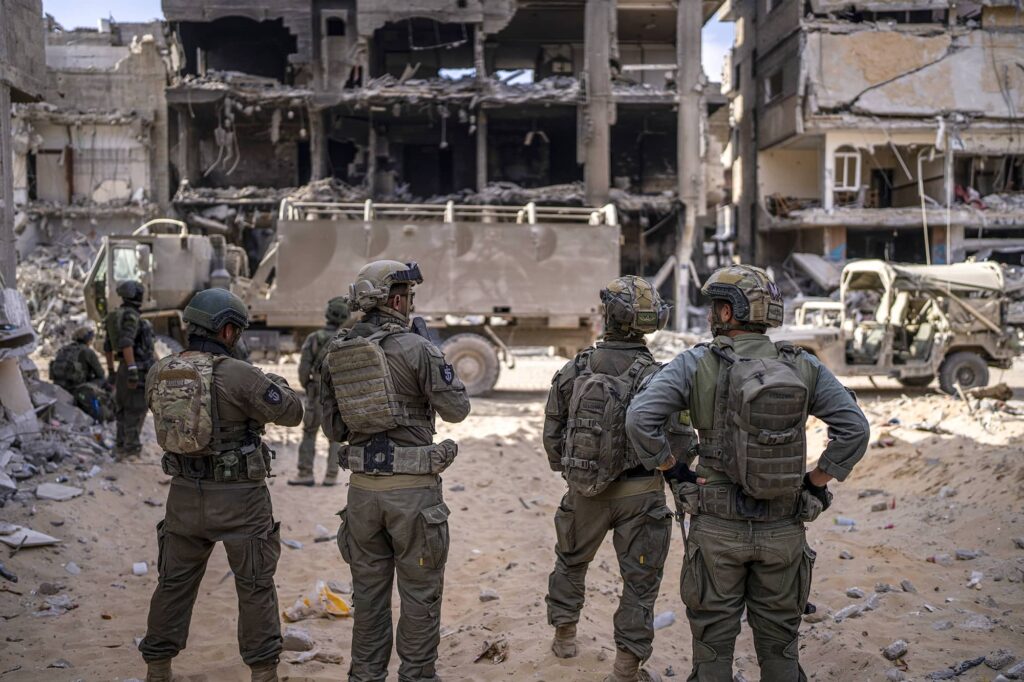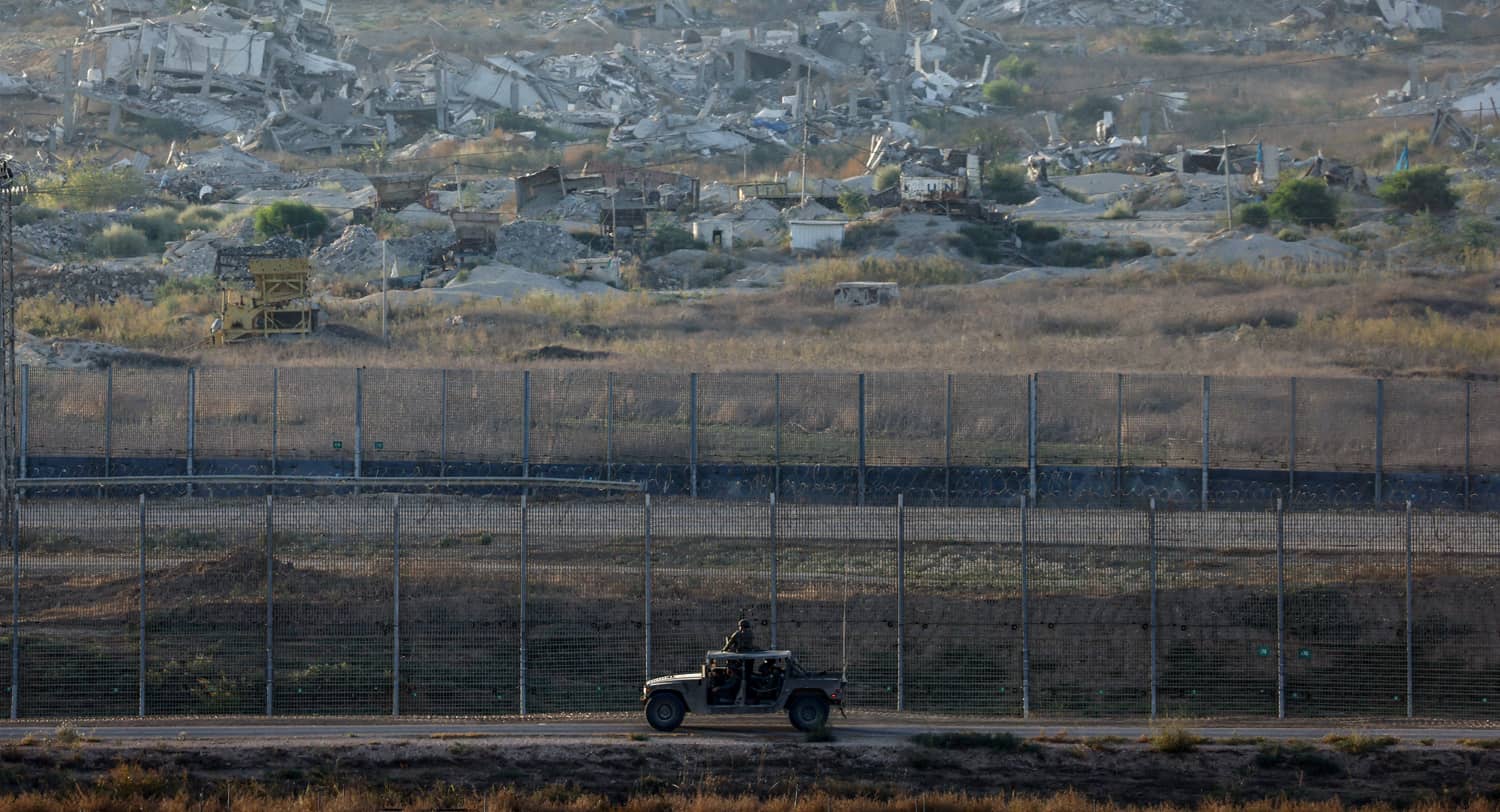Large-scale Israeli military operations against Hamas in Gaza are winding down and the Israel Defense Forces (IDF) is focused on Hizbullah in the north. Now the Israel government and the IDF face the long-postponed question of postwar planning for Gaza. Two options are under discussion: a multinational mission or an Israeli military administration, both as transitions to local governance. Meanwhile, lower-intensity battles with remaining Hamas terrorists continue daily in Gaza.
No formal decision has been made by the Israeli government so far. According to multiple media reports, the IDF leadership and Defense Minister Yoav Gallant oppose an Israeli military administration in Gaza, and consistently argue against it whenever it is floated in cabinet meetings.
Current Military Situation in Gaza
On September 12, the IDF announced that it had dismantled Hamas’s last remaining territorial brigade, the Rafah brigade, killing over 2,000 of this brigade’s terrorists and destroying some 13 kilometers of tunnels in the process. Some 80 percent of the tunnels near the Gaza-Egypt border have been destroyed.
Defense Minister Gallant released a letter purportedly penned by the Khan Younis Brigade commander of Hamas, Rafa Salameh, who was killed together with Hamas military chief Muhammad Deif in July. According to this letter: 70 percent of Hamas’s weaponry is destroyed, including 95 percent of its rocket arsenal, and only 20 percent of Hamas terrorists remain on the battlefield (50 percent were killed or injured and many others have fled, according to the letter.)
Hostages-for-ceasefire talks remain stalled, with Hamas continuing to demand a full Israeli withdrawal from the Strip, so that it can begin to rebuild its terrorist army with Iranian assistance and re-establish its political regime. Politically, Hamas continues to cling to survival through hasty recruitment of Gazan youth and the hijacking of humanitarian aid, as well as holding on to Israeli hostages,
These indicators point to a decision needed soon on the post-Hamas future of Gaza, including security arrangements and governance. In Israel, the main strategic question facing decision makers now is how to prevent Hamas’s resurgence.
A Temporary Multinational Authority for Postwar Gaza
James Jeffrey, former deputy national security advisor of the United States from 2007 to 2008, outlined in The Jerusalem Strategic Tribune in May 2024 a plan for a multinational authority to temporarily administer Gaza, after Israeli forces pull out, offering Gaza’s population a chance to live with dignity and security alongside Israel. The Authority would be organized by the US with its Middle Eastern and international allies; it would operate under a unified command with the mission to stabilize Gaza, dismantle Hamas’s civilian governance and replace it with local non-Hamas actors, and begin the reconstruction of Gaza’s infrastructure and economy.
Jeffrey, and a team of former US foreign policy and military experts including Lt. General Keith Dayton, formulated this comprehensive plan which was published in May by the Atlantic Council and the Wilson Center. It is the most-detailed of several proposals for an international force in Gaza. The Authority’s legal framework could stem from a UN Security Council resolution or from agreements with the Palestinian Authority (PA), Egypt, Israel, and key international stakeholders in the Contact Group.
The Authority’s security force would conduct “presence patrols” until a vetted, post-Hamas civil police force and gendarmerie are trained to take over. The policing force would include a small number of American military personnel for leadership, logistics, and intelligence roles. The involvement of the US is critical to ensuring participation from other countries, according to this plan, and this model is based on previous multinational efforts in Bosnia, Kosovo, and Iraq.
This plan has skeptics in Israel who doubt its sustainability at this stage in the conflict, when Hamas remains intact on the ground as an asymmetric guerilla force with thousands of armed terrorists, and its leadership is determined to quickly rebuild its forces following a ceasefire. Hamas has been systematically looting and hijacking humanitarian aid entering Gaza, using it to bolster its political standing among the Gazan population by monopolizing aid distribution, and to feed and fuel its terrorists.
Given the severity of the threat posed by Hamas to any multinational force, the idea that any entity other than the IDF has the capability and motivation to prevent a Hamas resurgence is doubted by many Israeli analysts.
Israeli skepticism is colored by its experience in southern Lebanon. After the 2006 war, triggered by Hizbullah raids into Israel, Israel attempted to ‘outsource’ the Lebanon mission to UNIFIL (United Nations Interim Force in Lebanon). UNIFIL has been unable to prevent Hizbullah’s military buildup despite UN Security Council Resolution 1701 prohibiting it from doing so. Hizbullah converted some 200 southern Lebanese villages into military bases, while building an Iranian-supported arsenal that is larger than that of most NATO militaries. Worse yet, UNIFIL bases have been used as shields by Hizbullah, which fires on Israel from within their vicinity in the hope that this will deter Israeli return fire.
Furthermore, Israelis reflect on their experience in the West Bank, where the Palestinian Authority relies heavily (though not publicly) on IDF raids to suppress Hamas and other terrorist groups. A similar dynamic would likely be necessary in Gaza. The IDF has been conducting security operations in the West Bank for more than 22 years after the 2002 Operation Defensive Shield. This operation was launched to extinguish a wave of terrorist bombings and shootings that killed over 1,000 Israels, most of them prior to the operation. Without such operations, Hamas would likely have supplanted the PA in the West Bank and established a new war front with Iranian backing.

The Alternative: A Temporary Israeli Military Administration
Several former members of the Israeli defense establishment have publicly challenged the reluctance of the IDF General Staff to set up a military administration, saying it is an unavoidable part of regime change in Gaza, and warning that failure to do so will guarantee Hamas regrouping into a terror army.
On September 4, Kobi Michael, a senior researcher at the Misgav Institute for National Security and Zionist Strategy, and at the Tel Aviv-based Institute for National Security Studies, stated in an interview on IDF Radio: “An [Israeli] military administration is required at this time…The issue of a military administration is the third stage, after conquering territory, and clearing it [of enemy forces], and it is the last stage before phase four, which is fostering a [Gazan] governmental alternative on the conquered territory.”
Both the Multinational Authority plan and the IDF administration plan agree on at least two things. First, either structure would be temporary in nature and designed to transition to Gazan, or alternatively Palestinian, governance. Second, the PA in the West Bank is at present incapable of governing Gaza. The PA lost legislative elections to Hamas in 2006 and then was violently ousted from Gaza by Hamas in 2007.
According to this assessment, the PA is neither capable nor willing to assume control of Gaza, after years of internal weakness and dwindling legitimacy among Palestinians. In a poll released in March by the Palestinian Center for Policy and Survey Research, 71 percent of Palestinians in Gaza and the West Bank supported Hamas’s actions during the October 7 attacks, and 56 percent believe Hamas will emerge victorious from the current conflict. This illustrates the depth of Hamas’s support within Gaza and further complicates any effort to install an alternative governing authority without a transition period, supported by a strong security presence on the ground.
Another alternative floated by Israelis – local administration led by Gaza clans – is dismissed by Michael as impractical. The Gazan clan structures differ significantly from those in the West Bank, and Hamas would likely continue its campaign of intimidation and assassination to prevent cooperation with any Israeli-backed administration. In his view, a temporary Israeli military administration, although costly in manpower and funds, is the most effective way to stabilize Gaza, ensure the distribution of humanitarian aid, and prevent Hamas from retaking power. This would involve securing critical infrastructure, such as hospitals, and maintaining law and order until a more permanent solution could be arranged.
There are significant concerns about the costs and duration of such an Israeli military administration. Israeli defense officials have reportedly warned that it could require up to five IDF divisions and cost up to $20 billion annually, as reported in May. Michael advocates for a narrower, more focused military administration that addresses immediate security concerns and the distribution of essential services, such as food, water, shelter, and medicine. This lighter model would still require substantial resources but would avoid the full-scale commitment that many fear could entangle Israel in Gaza indefinitely.
Other concerns are emerging from former security officials. Moshe Elad, a former Israeli military governor in the West Bank and in southern Lebanon, opposes a prolonged Israeli presence in Gaza. Drawing on past experiences in Lebanon, Iraq, and Afghanistan, he warns that the IDF would become a magnet for terrorist attacks, leading to car bombings and other deadly attacks against Israeli forces. He contends that military administrations inevitably become entrenched, making it difficult for the occupying power to extricate itself. Instead, Elad advocates for a regional solution involving Egypt taking the lead in administering Gaza, given its shared border with Gaza, with financial support from Gulf states, possibly in cooperation with the Palestinian Authority after a period of stabilization. There is no indication, however, of a regional interest in taking the initiative to govern Gaza.
Conclusion
A multinational mission led by the US, along the lines proposed by Jeffrey and company, is appealing to many in Israel – given the already over-stretched military and concerns with deteriorating international standing. Certainly Palestinians would prefer it to an Israeli military occupation.
But the multinational concept faces several major hurdles. First, the US, with the support of at least some of its allies, both within and without the Middle East, would have to adopt this concept. Second, the security component of such a force would have to be sufficiently robust to establish order on the ground and root out and replace the civilian side of Hamas.
Even if such an authority is established, the IDF will still require the freedom to conduct counter-terrorism operations in Gaza to ensure that Hamas does not rebuild its capabilities, as it has done several times after previous wars with Israel.

